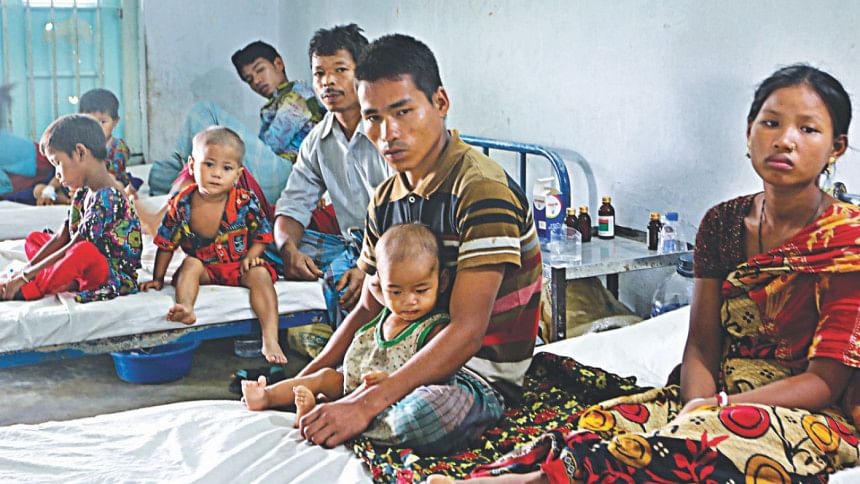'Disease new', problem old

Seven more children became sick yesterday in Sitakunda's Tripura Para where nine others died this week showing similar symptoms.
Forty four other children from the remote hilly area in Chittagong were hospitalised on Wednesday. They are believed to have been suffering from the same disease, which has not been identified yet.
Meanwhile, a team from the Institute of Epidemiology, Disease Control and Research in Dhaka visited the victims and collected their saliva, urine and blood samples for tests.
“The cause of the disease might be known once we get the test results. It would take six to seven days,” Chief Scientific Officer Faruk Ahmed Bhuiyan, who led the team, told The Daily Star.
All the victims are between one and 12 years old and the symptoms include fever, rash, breathing problems, vomiting, and blood in stool, said Azizur Rahman Siddique, civil surgeon of the district.

Of them, 13 are admitted to Chittagong Medical College Hospital while the rest to Bangladesh Institute of Tropical and Infectious Disease in Sitakunda's Fouzdarhat, he said.
Faruk said all of them had been suffering from malnutrition for long. For this reason, their immune system was weak. Some of them were already suffering from diseases like measles and diarhoea.
Health officials had already taken their blood and urine samples and tested for malaria, typhoid and paratyphoid. But the results were negative, he said, adding, “We will now try to find out whether it is chikungunya, swine flu or any other disease.”
Faruk also said they would test the water and food found in Tripura Para.
Talking about the seven children who became ill yesterday, Civil Surgeon Azizur said, ”They were very weak. But their condition was improving as they were on a nutritious diet at the hospital in Fouzdarhat.”
Dr Enshad Ekramullah, assistant professor of medicine at the hospital, echoed the same.
DELAY IN PROPER TREATMENT
As children were falling sick one by one since early last week, their parents did not take them to the hospital. They opted for local quacks and shamans, said locals.
Some parents said they performed different rituals seeking their recovery.

Nishiram Tripura, the oldest man in Tripura Para where some 64 indigenous families live, said he had never seen so many children becoming ill at a time.
“When the children were dying or becoming sick, we performed many rituals. Some of the ailing kids were washed with boiled water,” said the man in his late 80s.
Some were given homeopathy treatment. In most cases, it did not work.
Nine children died in four days since Sunday. Four of them died on Wednesday, prompting the parents to take their children to Sitakunda Upazila Health Complex, which is about 15kms away.
NOT VACCINATED
Enshad and Faruk told The Daily Star that none of the children was vaccinated.
Rajkumar Tripura, a local, said they had no idea about the vaccination programmes. He also claimed that health workers had not visited the area for a long time.
Asked why the sick children had not been admitted to hospital before, he said, “Who would do that? We live from hand to mouth. How can we afford to buy medicines that would have been prescribed by doctors?”
Almost all the people in that area are extremely poor. The males mainly work in orchards and jhum lands, he said.
Shyam Charan Tripura, a physically-challenged person who cannot work, was compelled to beg to feed his family. When his eight-year-old son Asam Tripura became ill, he could not do anything for his treatment.
The boy died on Wednesday.

CRISIS OF DRINKING WATER
The families in Tripura Para mainly collect their drinking water from a small canal in the hilly area. Sometimes, wastes are dumped into that water body, making the water dirty.
There is only one deep tube well there. It, however, went out of order two years ago.
Gunadhan Tripura, another local, said they do not boil water before drinking.
Contacted, local UP member Nasir Uddin said he was unaware that the tube well was not working. “Actually, they did not inform us about it. If they don't tell us then how can we know about it?”

 For all latest news, follow The Daily Star's Google News channel.
For all latest news, follow The Daily Star's Google News channel. 








Comments